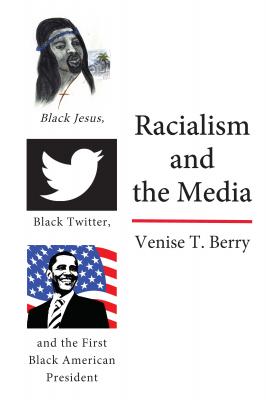ТОП просматриваемых книг сайта:
Racialism and the Media. Venise T. Berry
Читать онлайн.Название Racialism and the Media
Год выпуска 0
isbn 9781433172915
Автор произведения Venise T. Berry
Жанр История
Серия Black Studies and Critical Thinking
Издательство Ingram
Ford, C., & Airhihenbuwa, C. (2010). Critical race theory, race equity, and public health: Toward antiracism praxis. American Journal of Public Health, 100(S1), 30–35.
←9 | 10→
Gray, H. (1989). Television, black Americans and the American dream. Critical Studies in Mass Communication, 6, 376–386.
Harris-Lacewell, M. (2003, November). The heart of the politics of race: Centering black people in the study of white racial attitudes. Journal of Black Studies, 34(2), 222–249.
Hill, J. (2008, March 21). LeBron should be more careful with his image. ESPN. Retrieved from http://www.espn.com/espn/page2/story?page=hill/080320
Jhally, S., & Lewis, J. (1992). Enlightened racism: The Cosby Show, audiences, and the myth of the American Dream. Boulder, CO: Westview Press.
“LeBron James ‘Vogue’ cover called racially insensitive. (2008, March 24). USA Today. Retrieved from https://usatoday30.usatoday.com/life/people/2008-03-24-vogue-controversy_n.htm
Martinez, A. (2014, November). Critical race theory: Its origin, history and importance to the discourses and rhetorics of race. Frame, Journal of Literary Studies, 27(2), 9–27.
Means Coleman, R. (2013). Say it loud! African-American audiences, media, and identity. New York, NY: Routledge.
Morris, W. (2008, March 31). Monkey business: So is that Vogue cover racist or not? Slate.com. Retrieved from http://www.slate.com/articles/arts/culturebox/2008/03/monkeybusiness.html
Napoli, P. (2010). Audience evolution new technologies and the transformation of media audiences. New York, NY: Columbia University Press.
Newman, W., & Guggenheim, L. (2011). The evolution of media effects theory: A six stage model of cumulative research. Communication Theory, 21, 169–196.
Nightingale, V. (2011). The handbook of media audiences. Hoboken, NJ: Wiley-Blackwell.
Potter, W., & Riddle K. (2007). A content analysis of media effects literature. Journalism and Mass Communication Quarterly, 84, 90–104.
Preiss, R., Gayle, E., Burrell, N., Allen, M., & Bryant, J. (2007). Mass media effects research: Advances through meta-analysis. New York, NY: Earlbaum.
Rocco, T., Bernier, J., & Bowman, L. (2014). Critical race theory and HRD: Moving race front and center. Advances in Developing Human Resources, 16(4), 457–470.
Ross, K., & Nightingale, V. (2003). Media and audiences: New perspectives. New York, NY: McGraw-Hill Education.
Sawrikar, P., & Katz, I. B. (2010). Only white people can be racist: What does power have to do with prejudice? Cosmopolitan Civil Societies, 2(1), 80–98.
Solorzano, D., & Yosso, T. J. (2002). Critical race methodology: Counter-storytelling as an analytical framework for education research. Qualitative Inquiry, 8(1), 23–44.
Stewart, D. (2008, March 17). Is Vogue’s Lebron Kong cover offensive? Jezebel.com. Retrieved from https://jezebel.com/368655/is-vogues-lebron-kong-cover-offensive
Thornton, S. (1996). Club cultures: Music, media and subculture capital. Middletown, CT: Wesleyan University Press.
Vogue Magazine. (2008, April). Lebron James and Giselle Bundchen. Retrieved from https://www.amazon.com/Vogue-April-Issue-Editors-Magazine/dp/B00168A5DM
West, C. (1994). Race Matters. New York, NY: Vintage Books.
←10 | 11→
Contemporary Zip Coons: The Problem with Funny
Many stereotypes are normalized in our society, especially through the media. Stereotypes are generalizations or overgeneralizations of a group or culture (Brigham, 1971). Unfortunately, many of the normalized stereotypes of African American culture confirm accepted distortions. In his research on implicit stereotypes, Hinton (2017) argues that “culture in mind” is key to influencing the cognition of cultural group members. He believes that stereotypes are predictions and the brain uses predictions based on the structures and meanings experienced in the world (p. 6). Therefore, stereotypes become a resource that enables the transmission of cultural information, specifically within a network where common understandings exist (Kashima & Young, 2010).
Burr (2001) identifies three issues concerning stereotypical images of African Americans in the media.
First, these images affect how African American children and adults view themselves … Second, these images affect African American adults because others tend to view these images as indicative of how African Americans really act and respond accordingly … Third, these images harm the entire society in that they create disharmony between reality and perception and decrease the chances of positive interactions between blacks and others. (p. 181)
It is important to remember that stereotypes are not inherently racist. Yet, because of their history, many generalizations come from a negative or problematic ←11 | 12→place. Today, stereotypes are ingrained in our mediated culture as routine. We use them in the everyday process of creating meaning. They are very persuasive and not easy to change.
Social Identity Theory
Social Identity Theory explores group membership and identity arguing that most people identify who they are in society based on the specific groups they belong to, in other words in-group or out-group perspectives (Tajfel & Turner, 1979). Since we exist in a constant cycle of experiencing the world and constructing meaning as members of various groups, Hinton (2000) suggests that we are more likely to accept stereotypes as norms when there is a consensus among friends, family members and even societal groups.
Social Identity Theory argues that through the cognitive process of categorization and grouping, the in-group members will develop a stereotypical view of the out-group members and through the process of seeking to maintain a relatively high social identity the stereotype of out-group members will tend to be negative. (pp. 114–115)
Hinton also believes that in-group members will view out-group members as more different than they really are from the in-group and they will see out-group members as more similar to each other than they actually are. For example, Banjo (2011) found that white viewers enjoyed stereotypical entertainment based on their cultural openness and competence concerning the out-group.
Viewers reported low-enjoyment when uncomfortable with entertainment that disparages out-group members and identified conflicts between attitude and behavior when interacting with black culture whether personal or mediated. (p. 153)
Gandy (1998)

